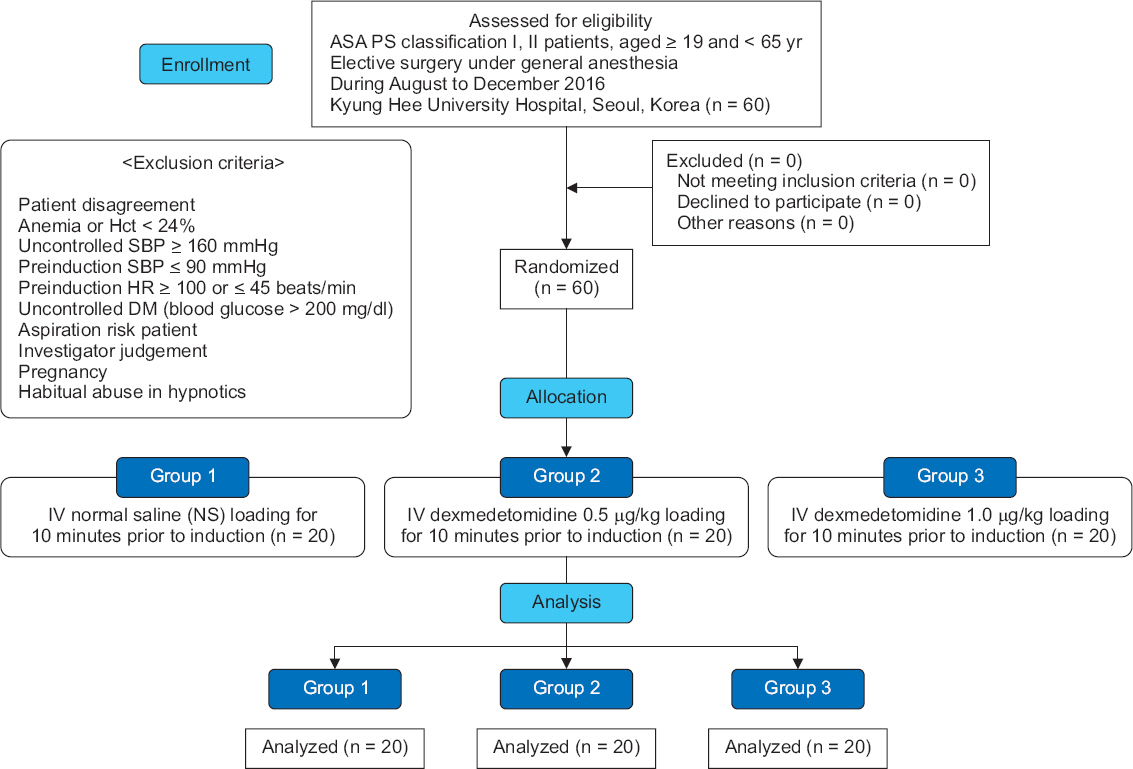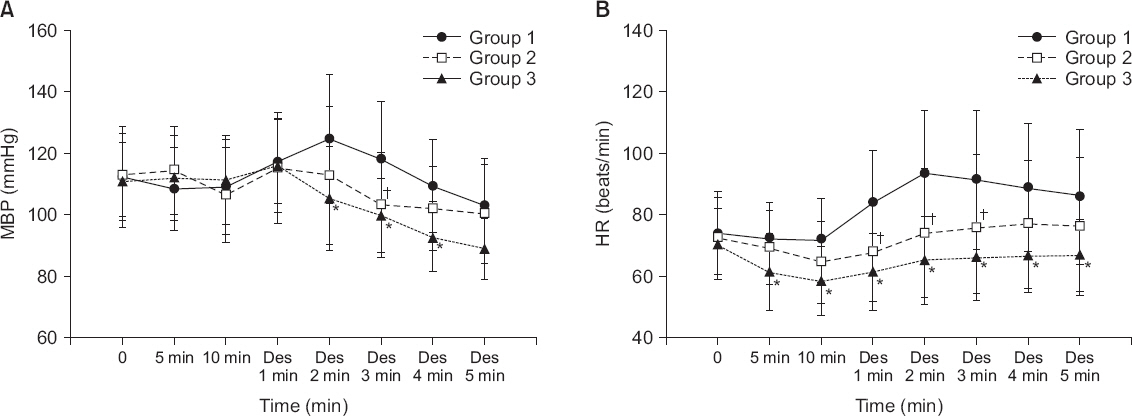Anesth Pain Med.
2018 Apr;13(2):158-164. 10.17085/apm.2018.13.2.158.
Blunting effect of dexmedetomidine on transient cardiovascular changes induced by inhalation of desflurane: a randomized controlled trial
- Affiliations
-
- 1Department of Anesthesiology and Pain Medicine, Kyung Hee University College of Medicine, Seoul, Korea. choikhang@gmail.com
- KMID: 2437422
- DOI: http://doi.org/10.17085/apm.2018.13.2.158
Abstract
- BACKGROUND
A rapid increase in desflurane concentration has been demonstrated to induce transient sympathetic hyperactivity and lead to increases in blood pressure and heart rate (HR). Additionally, the use of dexmedetomidine as an anesthetic adjunct has been reported to attenuate intraoperative sympathetic responses. We examined the hemodynamic effects of dexmedetomidine infusion before anesthetic induction on desflurane-induced cardiovascular changes.
METHODS
Patients were randomly divided into three groups. They received either normal saline (NS) (group 1, only NS) or dexmedetomidine solution diluted in 50 ml NS (group 2, 0.5 µg/kg; group 3, 1.0 µg/kg) for 10 minutes with a syringe pump before anesthetic induction. Desflurane was administered at a vaporizer dial setting of 8% for 5 minutes by manual ventilation.
RESULTS
In group 1, the HR significantly increased above the baseline during the entire 5 minutes after desflurane inhalation and the mean blood pressure (MBP) significantly increased above the baseline at 1, 2, and 3 minutes after desflurane inhalation. However, in groups 2 and 3, the increases in HR and MBP induced by desflurane inhalation were significantly suppressed. The HR and MBP in group 2 remained closer to the baseline than in group 3.
CONCLUSIONS
A loading infusion of dexmedetomidine for 10 minutes before induction of general anesthesia effectively attenuates the transient cardiovascular stimulation induced by desflurane inhalation, without significant hemodynamic side effects. The HR and MBP remained closer to the baseline after administration of 0.5 µg/kg dexmedetomidine than after administration of a dose of 1.0 µg/kg.
Keyword
MeSH Terms
Figure
Reference
-
1. Jakobsson J. Desflurane: a clinical update of a third-generation inhaled anaesthetic. Acta Anaesthesiol Scand. 2012; 56:420–32. DOI: 10.1111/j.1399-6576.2011.02600.x. PMID: 22188283.2. Ebert TJ, Muzi M. Sympathetic hyperactivity during desflurane anesthesia in healthy volunteers. A comparison with isoflurane. Anesthesiology. 1993; 79:444–53. DOI: 10.1097/00000542-199309000-00006. PMID: 8363068.3. Weiskopf RB, Moore MA, Eger EI 2nd, Noorani M, McKay L, Chortkoff B, et al. Rapid increase in desflurane concentration is associated with greater transient cardiovascular stimulation than with rapid increase in isoflurane concentration in humans. Anesthesiology. 1994; 80:1035–45. DOI: 10.1097/00000542-199405000-00013. PMID: 8017643.4. Helman JD, Leung JM, Bellows WH, Pineda N, Roach GW, Reeves JD 3rd, et al. The risk of myocardial ischemia in patients receiving desflurane versus sufentanil anesthesia for coronary artery bypass graft surgery. The S.P.I. Research Group. Anesthesiology. 1992; 77:47–62. DOI: 10.1097/00000542-199207000-00008. PMID: 1535185.5. Weiskopf RB, Eger EI 2nd, Noorani M, Daniel M. Fentanyl, esmolol, and clonidine blunt the transient cardiovascular stimulation induced by desflurane in humans. Anesthesiology. 1994; 81:1350–5. DOI: 10.1097/00000542-199410000-00011. DOI: 10.1097/00000542-199412000-00008. PMID: 7992902.6. Yonker-Sell AE, Muzi M, Hope WG, Ebert TJ. Alfentanil modifies the neurocirculatory responses to desflurane. Anesth Analg. 1996; 82:162–6. DOI: 10.1097/00000539-199601000-00030. DOI: 10.1213/00000539-199601000-00030. PMID: 8712395.7. Jeong HJ, Baik HJ, Kim JH, Kim YJ, Bahk JH. Effect-site concentration of remifentanil for minimizing cardiovascular changes by inhalation of desflurane. Yonsei Med J. 2013; 54:739–46. DOI: 10.3349/ymj.2013.54.3.739. PMID: 23549824. PMCID: PMC3635645.8. Carollo DS, Nossaman BD, Ramadhyani U. Dexmedetomidine: a review of clinical applications. Curr Opin Anaesthesiol. 2008; 21:457–61. DOI: 10.1097/ACO.0b013e328305e3ef. PMID: 18660652.9. Jalonen J, Hynynen M, Kuitunen A, Heikkilä H, Perttilä J, Salmenperä M, et al. Dexmedetomidine as an anesthetic adjunct in coronary artery bypass grafting. Anesthesiology. 1997; 86:331–45. DOI: 10.1097/00000542-199702000-00009. PMID: 9054252.10. Menda F, Köner O, Sayin M, Türe H, Imer P, Aykaç B. Dexmedetomidine as an adjunct to anesthetic induction to attenuate hemodynamic response to endotracheal intubation in patients undergoing fast-track CABG. Ann Card Anaesth. 2010; 13:16–21. DOI: 10.4103/0971-9784.58829. PMID: 20075530.11. Turgut N, Turkmen A, Gökkaya S, Altan A, Hatiboglu MA. Dexmedetomidine-based versus fentanyl-based total intravenous anesthesia for lumbar laminectomy. Minerva Anestesiol. 2008; 74:469–74. PMID: 18762754.12. Noh C, Ko YK, Kim YH, Lim CS, Chung WS, Lee JY, et al. Effect of dexmedetomidine on endotracheal intubating conditions during endotracheal intubation without neuromuscular blocker following propofol/remifentanil. Anesth Pain Med. 2017; 12:56–61. DOI: 10.17085/apm.2017.12.1.56.13. Kersten J, Pagel PS, Tessmer JP, Roerig DL, Schmeling WT, Warltier DC. Dexmedetomidine alters the hemodynamic effects of desflurane and isoflurane in chronically instrumented dogs. Anesthesiology. 1993; 79:1022–32. DOI: 10.1097/00000542-199311000-00021. PMID: 7902030.14. Feld J, Hoffman WE, Paisansathan C, Park H, Ananda RC. Autonomic activity during dexmedetomidine or fentanyl infusion with desflurane anesthesia. J Clin Anesth. 2007; 19:30–6. DOI: 10.1016/j.jclinane.2006.05.019. PMID: 17321924.15. Sulaiman S, Karthekeyan RB, Vakamudi M, Sundar AS, Ravullapalli H, Gandham R. The effects of dexmedetomidine on attenuation of stress response to endotracheal intubation in patients undergoing elective off-pump coronary artery bypass grafting. Ann Card Anaesth. 2012; 15:39–43. DOI: 10.4103/0971-9784.91480. PMID: 22234020.16. Basar H, Akpinar S, Doganci N, Buyukkocak U, Kaymak C, Sert O, et al. The effects of preanesthetic, single-dose dexmedetomidine on induction, hemodynamic, and cardiovascular parameters. J Clin Anesth. 2008; 20:431–6. DOI: 10.1016/j.jclinane.2008.04.007. PMID: 18929283.17. Unlugenc H, Gunduz M, Guler T, Yagmur O, Isik G. The effect of pre-anaesthetic administration of intravenous dexmedetomidine on postoperative pain in patients receiving patient-controlled morphine. Eur J Anaesthesiol. 2005; 22:386–91. DOI: 10.1017/S0265021505000669. PMID: 15918389.18. Gulabani M, Gurha P, Dass P, Kulshreshtha N. Comparative analysis of efficacy of lignocaine 1.5 mg/kg and two different doses of dexmedetomidine (0.5 µg/kg and 1 µg/kg) in attenuating the hemodynamic pressure response to laryngoscopy and intubation. Anesth Essays Res. 2015; 9:5–14. PMID: 25886414. PMCID: PMC4383101.19. Lawrence CJ, De Lange S. Effects of a single pre-operative dexmedetomidine dose on isoflurane requirements and peri-operative haemodynamic stability. Anaesthesia. 1997; 52:736–44. DOI: 10.1111/j.1365-2044.1997.169-az0303.x.20. Scheinin B, Lindgren L, Randell T, Scheinin H, Scheinin M. Dexmedetomidine attenuates sympathoadrenal responses to tracheal intubation and reduces the need for thiopentone and peroperative fentanyl. Br J Anaesth. 1992; 68:126–31. DOI: 10.1093/bja/68.2.126. PMID: 1347229.21. Bousquet P, Feldman J, Bloch R, Schwartz J. The nucleus reticularis lateralis: a region highly sensitive to clonidine. Eur J Pharmacol. 1981; 69:389–92. DOI: 10.1016/0014-2999(81)90490-8.22. Kubo T, Misu Y. Pharmacological characterisation of the alpha-adrenoceptors responsible for a decrease of blood pressure in the nucleus tractus solitarii of the rat. Naunyn Schmiedebergs Arch Pharmacol. 1981; 317:120–5. DOI: 10.1007/BF00500066. PMID: 6117801.23. Feringa HH, Bax JJ, Boersma E, Kertai MD, Meij SH, Galal W, et al. High-dose beta-blockers and tight heart rate control reduce myocardial ischemia and troponin T release in vascular surgery patients. Circulation. 2006; 114(1 Suppl):I344–9. PMID: 16820598.24. Mukhtar AM, Obayah EM, Hassona AM. The use of dexmedetomidine in pediatric cardiac surgery. Anesth Analg. 2006; 103:52–6. DOI: 10.1213/01.ane.0000217204.92904.76. PMID: 16790625.25. Mangano DT, Hollenberg M, Fegert G, Meyer ML, London MJ, Tubau JF, et al. Perioperative myocardial ischemia in patients undergoing noncardiac surgery--I: Incidence and severity during the 4 day perioperative period. The Study of Perioperative Ischemia (SPI) Research Group. J Am Coll Cardiol. 1991; 17:843–50. DOI: 10.1016/0735-1097(91)90863-5.
- Full Text Links
- Actions
-
Cited
- CITED
-
- Close
- Share
- Similar articles
-
- Desflurane Inhalation Provide Cardiovascular Stability During Intubation but Prevention of Rocuronium Injection Pain
- Optimal effect-site concentration of remifentanil for preventing development of hypertension during tracheal intubation with inhaled desflurane induction
- The target concentration of remifentanil to suppress the hemodynamic response to endotracheal intubation during inhalational induction with desflurane
- Comparison of the Effects on Increase of Heart Rate and Blood Pressure between Tracheal Intubation and Desflurane Inhalation during Propofol Anesthesia
- The effect of dexmedetomidine sedation on patient and surgeon satisfaction during retinal surgery under sub-tenon's anesthesia: a randomized controlled trial



